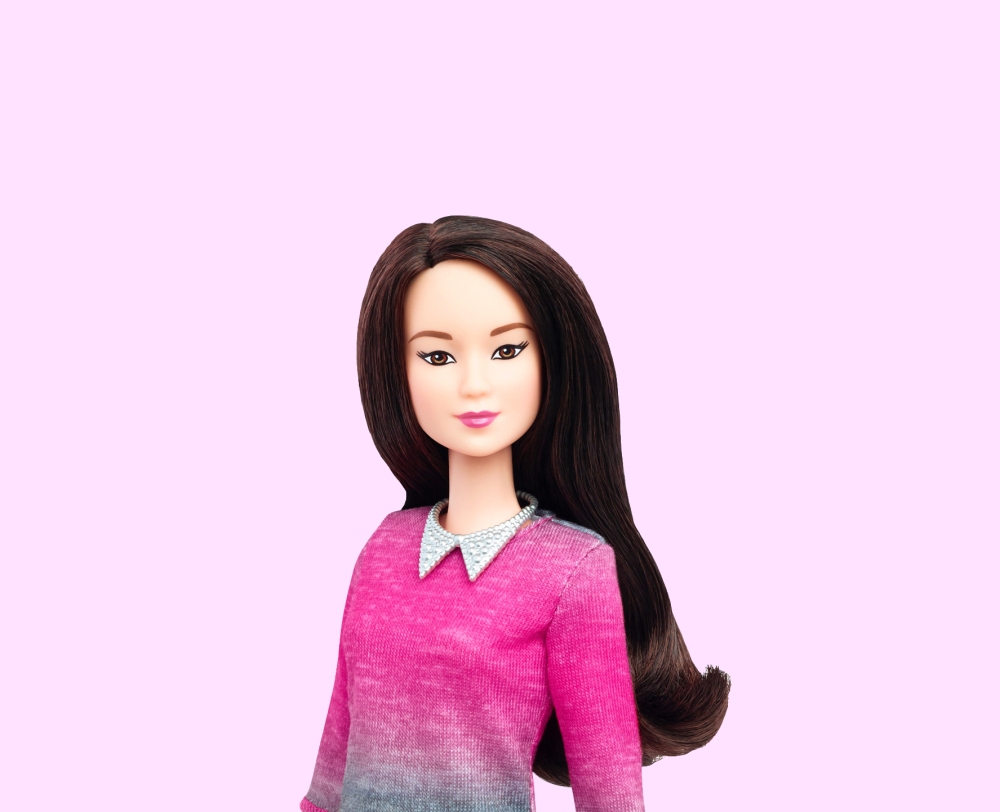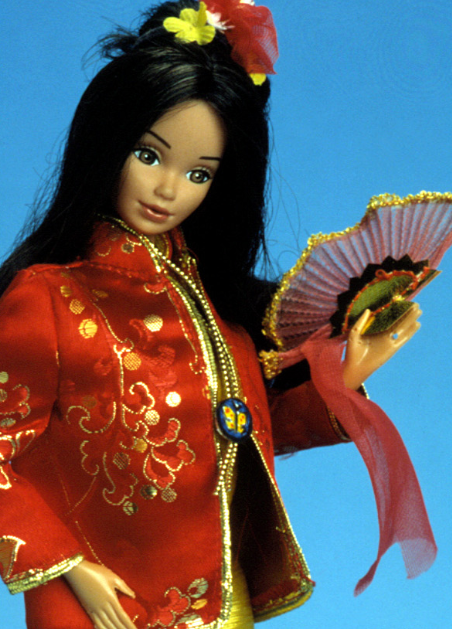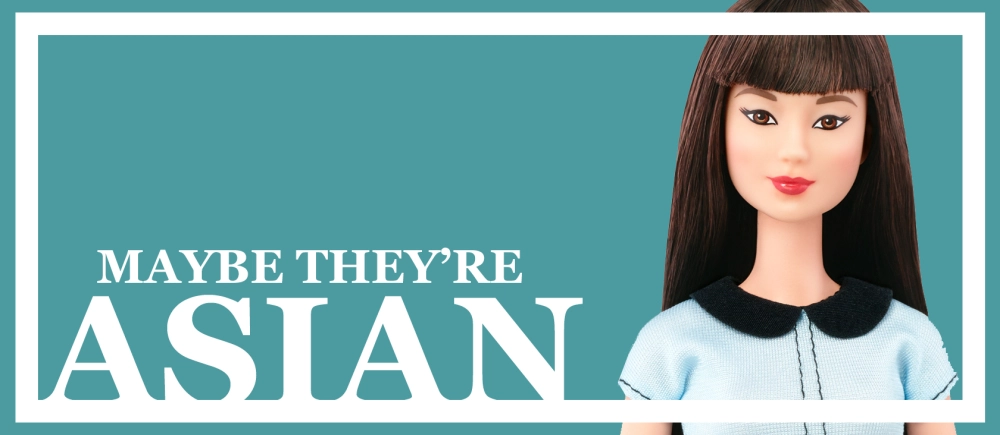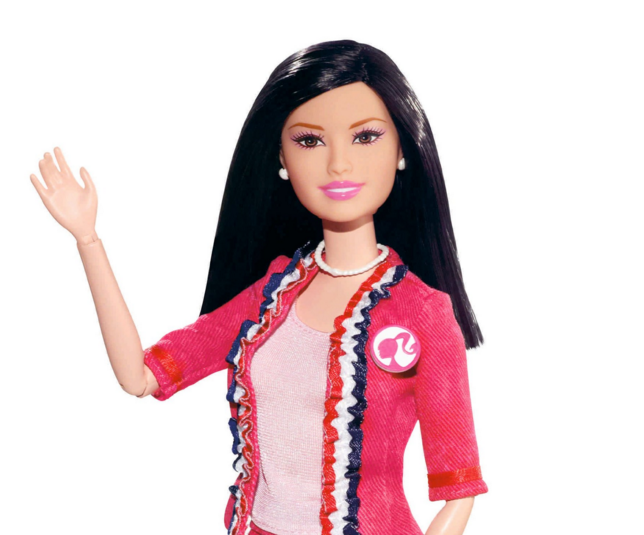Mattel “evolved” by creating a more inclusive line of Barbies with a range of skin colors, eye colors and body types. “Asian” Barbie, however, doesn’t come with a curvy figure – a look at the brand’s history of perpetuating stereotypes.

Curvy, petite, tall and original – using the hashtag #TheDollEvolves, Mattel announced its release of three new body types for their Barbie brand dolls last Thursday. As a lover of toys and a recent buyer of a 1988 South Korea Barbie, I checked the new collection for Asian representation and, no doubt, Asian barbies are included. But I noticed one other thing: there were no “curvy“ Asian dolls in the collection.
One of the everlasting stereotypes of Asian women is that they are naturally thin, and it seems that Mattel agrees – the company is arguably making a statement by omission when they exclude an Asian “curvy” doll. Such a statement, however, is lost in the excitement of an iconic brand marketing progressive ideas of inclusion, “evolution” and increased diversity; A quick analysis using Keyhole.co and Social Mention show mostly neutral or positive use of the #TheDollEvolves hashtag online, with an estimated reach of over 3.6 million.

To be fair, the new Barbies definitely could be a sign of progress in the arena of diversity and representation. When I was a kid, a Disney brand Mulan and a smaller, 1998 McDonalds Happy Meal Mulan doll were the closest things I had to this. Disney Mulan was too large to fit into Barbie’s more modern, stylish clothes (so she always looked like she was from a Dynastic era) and Happy Meal Mulan’s limbs became too nimble and loose from overuse. These dolls were distinctly foreign in the way they were designed, while my white and black barbies at the time were American roller skaters, flight attendants and veterinarians.
I decided to dig deeper. Was it always this way?

Asian Barbies and the “Dolls of the World” Collection
Kevin Powell, a renown politics and culture writer, once referred to the widespread suburban, white male consumption of hip hop music as a “cultural safari.” The phrase alludes to a sense of fascination with a facet of another’s culture.
As cultural critic Kevin Powell puts it, white fascination with hip-hop is ‘just a cultural safari for white people.’ It’s safe because you can ‘take it off.’ … Cultural identification does not necessarily lead to political alliance. (Michael Kimmel, The Gendered Society)
For Mattel in the 1980s, there may have been a market opportunity to create dolls that allowed young Americans to join in on a similar “cultural safari.” Several Barbies were designed and packaged to represent a country, often dressed in Mattel’s rendition of the culture’s traditional garb. For Asian Barbies, the first one likely was the 1981 “Oriental Barbie,” marketed as “dainty and elegant in [her] costume reflecting the influence of the Orient.” Barbie’s official website describes Oriental Barbie in a way that emphasizes her “long, slender” dress and “lustrous black hair.”

The stereotypical imagery in these words mirrored Oriental Barbie’s nondescript “Asian-ness.” And other than the sheer irritation of Oriental Barbie not having any specific ethnicity, America’s first Asian Barbie is problematic in that it speaks to an era (and a continued phenomenon) in which Asian-Americans are inherently made to feel both foreign and all the same. It reminds me, a hapa Korean-American, of all the times people assumed I am Chinese (I’m not).
Oriental Barbie’s vagueness is a great example of a term coined by Sociologist Robert Park called the “racial uniform.” Journalist Alex Tizon elaborates on this term in his book, Big Little Man, arguing that people become more “Asian” the longer they’ve been in the United States.
Years of checking “Asian” on countless forms, of being subjected to the same racial epithets and compliments … all of these would compel young Vietnamese, Cambodians and Filipinos to accept their belonging to the category known as Asians. Perhaps the most unifying force was the perception that everyday Americans saw them as the same (57)
To be fair, I am not condemning Mattel as a source of evil.
Oriental Barbie is largely a product of her time – a period when Asian American issues were just being heard.
A year after Oriental Barbie’s release, the infamous murder of Vincent Chin garnered national media attention.
Chin, A Chinese-American just days away from his wedding, was mistaken as Japanese. He was brutally murdered by two white, auto industry workers who were angry at layoffs and the rise of Japanese cars. The murderers didn’t serve any jail time, and Chin’s tragic death is often regarded as the starting point of a pan-Asian civil rights movement.
Nonetheless, just a few years after Oriental Barbie came out, country-specific Asian Barbies were released.

When I first unwrapped my $9 eBay purchase of the 1988 Korean Barbie, I raised an eyebrow at the back of the box and attempted to imagine myself as a white, suburban 9-year-old in the 1980s. Without access to a personal computer or likely much pop culture coming out of Korea, my perceptions of South Koreans would likely be based off of this description:
Anyaha simnika! (Hello!) from South Korea, “The Land of the Morning Calm” … Seoul is the capital city of South Korea. It’s one of the world’s 20 largest cities! Our main crop in South Korea is rice. At harvest time, farmers’ families work together to bring in the crops. Each year there is a Harvest Festival in Seoul to celebrate the end of the spring planting. There are jugglers, acrobats, dancers and magicians. The children eat rice candies and fly beautiful kites shaped like dragons and fish.
The end of the lengthy description encouraged kids to consider visiting “The Land of the Morning Calm” and made a point to distinguish South Korea and its language from China and Japan – perhaps a step of progress considering there was just one overall-Asian, “Oriental Barbie” seven years earlier.
In total, Mattel created 17 “Dolls of the World” Barbies between 1981 and 2012. The 1990s recreated some of these Barbies while adding others, such as Malaysian Barbie, Chinese Barbie and Thai Barbie. Between 2000 – 2012, Sumatra-Indonesia Barbie, Philippines Barbie and a Japanese Ken were also added.
And they may have reinforced stereotypes.
According to the Barbie website, Japanese Ken is the first (and perhaps only) ever Ken doll to be added to the Dolls of the World Collection, describing him as “both handsome and exotic.” The Indian Barbie is “Bollywood ready,” and comes with a “monkey friend,” while the Chinese Barbie comes with a panda (facepalm).

Some may argue that fashion is at the very core of this collection, as it is with the Barbie brand. The traditional attire can be perceived as celebratory of a variety of cultures and histories, even if they present them in a stereotypical, “othering” way.
There’s also the question of whether or not Barbie and other toy manufacturers have an ethical responsibility to be fair and representative with their products.
Right now, Barbie is more or less arguing that it does – the hashtag #TheDollEvolves essentially recognizes that things should have been done differently in the past; that the company has evolved to being more aware.

Barbies are usually not labeled “Asian”
Mattel’s “Dolls of the World” collection make it easy to identify Asian Barbies. The other collections don’t.
Whether or not Mattel is willing to explicitly identify some of their past characters as Asian, the truth is that consumers have already done it for them. Fan sites for Barbie collectors and third-party sellers online often decide the racial backgrounds of the dolls kids are playing with, as this website did by charting Barbie’s “ethnic friends” based on face molds Mattel used in the past to create Barbie’s friend characters.
After searching through a variety of sites, I identified a few characters who were widely identified as Asian. Many of them were built using a base “oriental face sculpt:”
- Dana, who appeared in the “Barbie and The Rockers” band collection (1986 – 1987)
- Becky, from the 1988 “Barbie and The Sensations” band collection
- Miko, a vaguely Hawaiian or Asian/Pacific Islander doll presented under branding such as “Beach Blast,” “Island Fun” and “Tropical Friend” (1980s)
- Kira, the seemingly 1990s version of Miko, who is usually dressed for the beach but also appeared as a super hero and an “all-American” wearing Reebok shoes
- Lea, a current Asian doll with no particular associations
- Raquelle, a character created in 2007 who took on an Asian identity starting in 2011. She is also a villainous character in the Barbie: A Fairy Secret movie and Barbie: Life in the Dreamhouse web series.
Raquelle, the problematic person of color
The Barbie website does not say whether or not Raquelle is Asian, but reviews of Raquelle dolls on Toys R Us, Amazon and blogs are telling me that many people think she is.
She may pass as an Asian character to children if she is passing as one to adults. If Raquelle was in the toy aisles when I was in 2003, my third-grade self would have wanted to believe that she was Asian.
Others may perceive her to be Hispanic or Latina, since the name Raquel (spelled differently) is Spanish and because the character rolls her R’s when she’s on a scheming rant about her master plans.
But so long as Raquelle is a person of color, her role may be problematic.
In Life in the Dreamhouse, Raquelle is Barbie’s wealthy “frenemy” who exhibits jealous, overly-competitive, and openly devious behavior. She tries (and fails) at winning Ken’s heart while he remains smitten by blonde-haired, blue-eyed Barbie.
Furthermore, Barbie lacks character flaws – she is usually clueless or chooses to take the moral high round while Raquelle greenly curses her perpetual second place status.

In one scene, Raquelle competes in a runway show against Barbie and falls off the stage into Ken’s arms. Ken asks if Raquelle is okay, to which she lewdly responds, “I am now – how about we ditch this low-rent production?”
Barbie then appears on the stage and instantly dazzles the crowd with her beauty – so much that Ken absentmindedly drops Raquelle and screams out to Barbie that he loves her.
The lesson is clear: the people of color in this show are no match for the prettier, more successful, more humble (white) Barbie.
Raquelle is the character we all want to laugh at, who we all want to feel pain. She can be seen getting hit in the face with frisbees or running from a mall cop who shoots stickers at her.


In one episode, Raquelle works hard on a sandcastle at the beach to impress Ken, but he instead is impressed by Barbie’s “architectural masterpiece.”
Raquelle’s brother Ryan, also a person of color, is a reinforcement of the “white wins” tale. Like Raquelle, Ryan’s one goal is to win the heart of the white protagonist, Barbie. Spoiler: Barbie is more interested in Ken.

A Barbie: Life in the Dreamhouse song encompasses this sentiment – called “Everybody Needs a Ken,” Barbie sings lyrics like, “Your smiling face, not a hair out of place, you’re a dream come true,” to a music video which largely depicts herself and Ken as perfect and Raquelle and Ryan as scheming losers.

I’m not the only one who noticed this. A tumblr blogger took similar issue with the show in August 2012, lamenting that the mostly-white cast overshadows and demeans background, vaguely person of color characters. The blogger cited a scene in which Barbie emerges out of the ocean water with perfect hair, while Raquelle’s hair springs up into an afro. Even worse, a fish gets caught in her hair:
The tumblr user is right: this is unforgivably offensive.
One little joke, so much racist propaganda. Raquelle’s inferiority to Barbie, itself already a bit ‘meah’ because I have no clue what she is but she sure doesn’t score as many Caucasian points as Barbie, in this joke is manifested through the use of white hair vs black hair, with white hair being presented as the good option and black hair the undesirable one. On top of that, it plays into the racist myth that black hair is unkempt, as the fish is clearly absent from Raquelle’s hair when it still resembles the Caucasian look (Parrotbeak.tumblr.com).
The show, which started only four years ago, has little excuse for this regressive, racially-charged humor. And it is certainly not consistent with Barbie’s “new image,” which pushes diversity and acceptance of all types of people.
The point: there’s plenty of room for improvement.
The same year as the season one release of Barbie: Life in the Dreamhouse, Mattel released the “Barbie for President 2012” doll collection. The collection explicitly labels the four variations of the dolls as “Caucasian, African-American, Asian and Hispanic.”

Released two years later in 2014, an Asian “Entrepreneur” marked what might be the second explicitly, non-“Dolls of the World” Barbie.

These dolls, adorned in regular, everyday clothing and representative of ambitious professions area nice step forward. However, these are the only two dolls for sale online that are identified as Asian in a franchise that claims diversity, but seems to have some very racialized mixed-messaging.
Furthermore, though the newer, “evolved” Barbies are a step in the right direction, one has to remember that this step was made following years of declining sales. It evokes the question of how genuine this inclusion is.
The good news is that, in the meantime, kids have more Asian Barbies to play with. Representation matters, especially for a population that is stereotypically regarded as a group of outsiders. Simon Cottle’s “Ethnic Minorities and the Media: Changing Cultural Boundaries” eloquently explains why:
It is in and through representations, for example, that members of the media audience are variously invited to construct a sense of who ‘we’ are in relation to who ‘we’ are not, whether as ‘us’ and ‘them’, ‘insider’ and ‘outsider’, ‘colonizer’ and ‘colonized’, ‘citizen’ and ‘foreigner’, ‘normal’ and ‘deviant’, ‘friend’ and ‘foe’, ‘the west’ and ‘the rest.’
I leave you with one thought: according to the US Census Bureau, a projected 40.6 million Asian-Americans will be living in the United States by 2050.
It’s time to make more Asian Barbies.
[For more updates, follow me on Twitter @KasulisK]






There are many odd and offputting aspects to Mattel’s relationship to various depictions of Asian characters in their dolls over the decades. Another one is that in 1976, well before the poorly thought out 1981 “Oriental Barbie” (sic), was the “Honey Hill Bunch” miniature play doll “I.Q.” With an adorable little girl face sculpt, she was just another one of little kids in the “playmate”-themed line. But that name… Its problematic nature was further emphasized by her one toy accessory being a “book.” (The other children had animals, flowers, a guitar, or a baseball bat.) “I.Q.’s” back of the box story similarly leaned heavily on a stereotype that became omnipresent in the media by the early ’80s. (http://dollreference.com/mattel_honey_hill_bunch_dolls.html)
Great article!
LikeLike
Reblogged this on EffigiPie and commented:
There are many odd and offputting aspects to Mattel’s relationship to various depictions of Asian characters in their dolls over the decades. Another one is that in 1976, well before the poorly thought out 1981 “Oriental Barbie” (sic), was the “Honey Hill Bunch” miniature play doll “I.Q.” With an adorable little girl face sculpt, she was just another one of little kids in the “playmate”-themed line. But that name… Its problematic nature was further emphasized by her one toy accessory being a “book.” (The other children had animals, flowers, a guitar, or a baseball bat.) “I.Q.’s” back of the box story similarly leaned heavily on a stereotype that became omnipresent in the media by the early ’80s. (http://dollreference.com/mattel_honey_hill_bunch_dolls.html)
LikeLike
I came here with one question in mind: why are there no ‘curvy asians’ in barbie’s new diversity campaign? I found the answer in this post. Many of the things you wrote sang true for me in so many ways, from the ambiguously asian dolls to the reinforcement of asian stereotypes. One sentence was particularly powerful: “I wanted to believe she was asian.” I have a distinct childhood memory where my sister and I would take our blonde barbie dolls and try to color their hair black with sharpie marker to look more like us. (Of course it didn’t work.)
Thank you for writing this poignant article! 🙂
LikeLike
In 1962 I got my 1st barbie. We lived in Japan at the time, she had black hair and wore a kimono and came with the black and white striped bathing suit.
LikeLike
Hello Kelly, I really enjoyed your article! Thanks for sharing!
As a brazilian mom living in Germany I bought Raquelle for my daughter thinking she was “latina”. When I looked to her on the shop, she reminded me Monica Belucci. I also took Teresa home. Now she has a pair of Barbies that reminds how the women in our family look.
Last year I bought her 2 different dark skinned Barbies with curly hair (Chandra and Asha I think).
Now I want to buy her 2 different “asian” dolls. I was wondering why they just have Lea as asian doll and if Raquelle is italian or east european when I stepped in your blog.
I also watched “Life in the Dreamhouse” with my daughter and I found it was offensive in so many ways!
As foreigner parents we struggle every day to show our kids we can achieve, we can do it, even if we are not blond with blue/green eyes. We always show them successful non-caucasian people to try to reinforce their self-steem. Then I saw Raquelle being the fool character on the film and asked my daughter to stop watching the movie and I explained her: “I don´t accept this clichée and you also don´t have. This movie is racist!” I also have other issues with the movie like you mentioned “Barbie is clueless”. Barbie is unfortunately a weak female character on the film and we don´t need it in our education. Since then no more Barbie films at our home.
And I agree with you, we need more asian Barbies, representing the abundance of different faces, hair and body shapes and also skin tones of the huge asian continent! I would be glad to buy them for my daughter!
LikeLike
I hope you realise that by assuming someone with a Spanish name that can roll her R’s is automatically someone of colour you’re stereotyping. How do you know that she wasn’t Spanish from Spain? Would that make it any better in your eyes if the villain wasn’t a POC?
Other than that I believe Mattel was usually more focused on fantasy and selling potential than perfect cultural accuracy, though for some reason, I expected way worse.
Seeing that Mulan doll made me think of the one I had, the ‘Secret Hero Mulan’. One of my favourite dolls when I was a kid.
All in all I think they should actually talk to kids and ask for what they would like to see in a doll. I’m all for diversity in dolls so kids can identify with them, but I don’t want this to turn into Mattel making dolls for adults to agree with or not, it’s the kid’s happiness that matters.
LikeLike
PS: Not sure if you know this one, but there was Mariko in Barbie’s “Generation Girls” who was clearly asian, and pretty damn cool at that. https://www.youtube.com/watch?v=aNmKqEQ_B-c
LikeLike
Very good piece. Thank you!
LikeLike
There’s not a petite Asian Barbie either but I guess that doesn’t bother you?
LikeLike
Lol there is a curry barbie I’m currently looking for her online
LikeLike
Wow cuz this is extremely great work! Congrats and keep it up. http://bit.ly/2f0xJ92
LikeLike
I never understood the need for people to “see themselves” in their dolls. I am a white female. I chose the 1977 Hawaiian Superstar Barbie because I thought she looked like my favorite actress, Romy Schneider (I had a B&W TV at the time, and thought Romy had black hair. My favorite heroine in books, Fantomette, also had black hair.) Did I ever think anything of the doll having dark skin? Not one minute.
And I never thought of my doll as an extension of me. She was my character, with a different name, personality and back history. She was in turn, a detective, a spy and a investigative journalist. She changed a lot during those years, of course, and now I write books, novellas and short stories about her and her friends and family. Not kids’ books, either.
I agree there should be diversity in the Barbie line, but that’s because there is diversity in the world, and we need to be able to make diverse characters, not because we need to have a “looks like me” crutch.
LikeLike
With all due respect, Liz, as a white person, you grew up in a world that overwhelmingly privileged depictions of people that looked like you, just as you, as a white woman, have had the privilege of not having had to grapple with race and racism. But just because you personally have not experienced it, does not make it any less true.
LikeLike